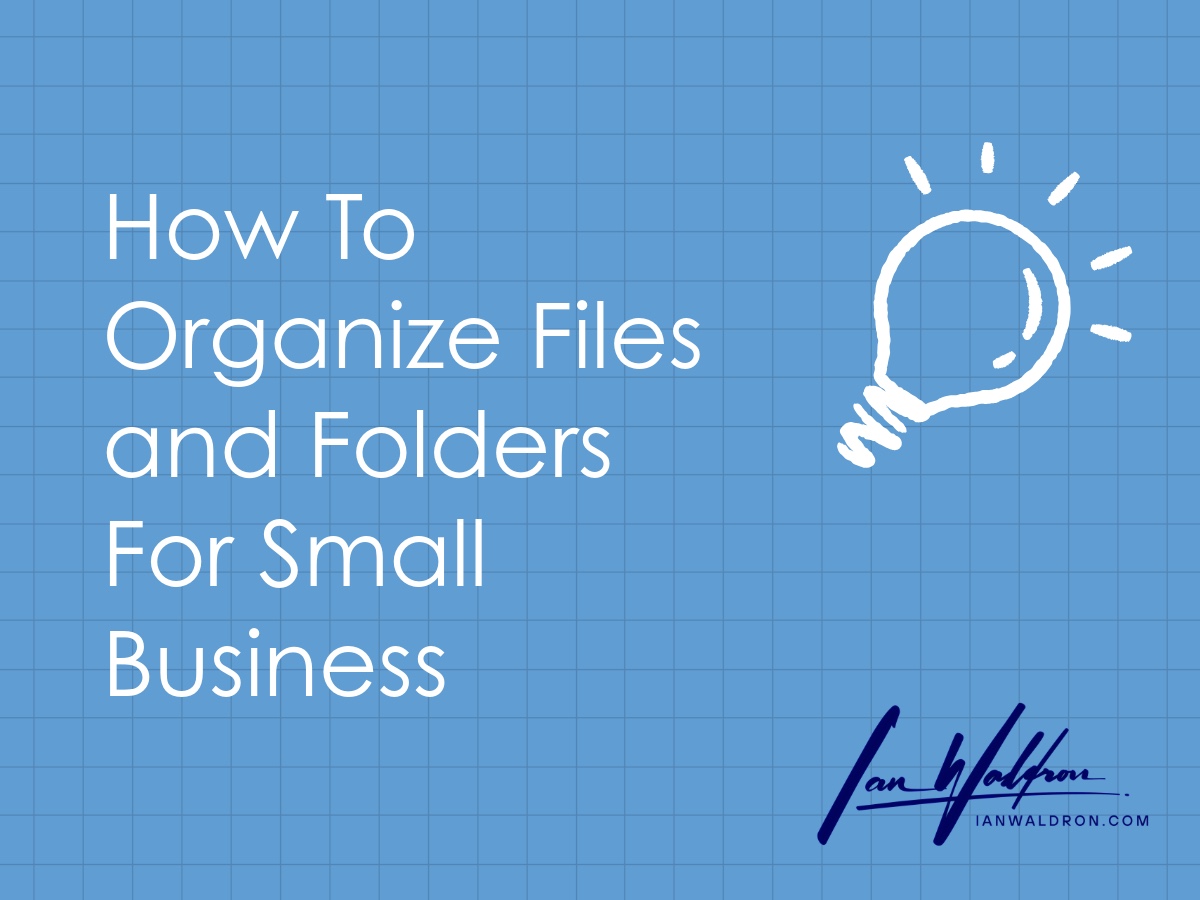Background
Keeping your business's digital resources organized is an important step in operating your efficiently. Procedures on how to name files and folders will allow you to quickly archive a resource without having to dwell on how to handle each particular item that comes through the door. A well named file and organized system will make a file's future retrieval fast and easy. This is a brief discussion on some of the approaches I use in my own businesses to accomplish exactly that.
If you're interested in digging in a bit deeper, take a look at these more detailed articles:
Balancing Objectives
Let's look at a couple high level objectives. The main purpose for any file management procedure or policy should be to make a resource easier to retrieve in the future. We store things in any context because we want to access them down the road. Placing that resource in the best location and with the best name will save time and effort later on.
The resource should be in a particular location that makes logical sense based on its context. This is folder organization. I should be able to navigate to the correct location in my file server intuitively based on the nature of what I'm looking for. Ideally, this should be obvious enough that you don't need to ask a colleague or refer to the company handbook for direction.
Then there's identifying the resource. It should be relatively simple to identify the particular resource I'm looking for while juxtaposed next to many similar items. This relates to the file name itself. This is where consistently applied standards come in to play.
But with any approach, you need to balance upfront effort compared to the benefit received on the back end (retrieval). A system that requires too much going in may not be applied consistently, may be tossed aside from fatigue, or will just be inefficient and therefore counterproductive.
Folders
The layout of your file server is accomplished by what folders you create and how you nest them. It's easy to jump in and start creating folders but I encourage you to invest thought into the process and develop a schema that reflects your organization's needs. When this process is loose, it's easy to produce overly flat or overly nested folder structures that make navigation difficult.
For top-level folders, I like to start with departments or core business functions like "administration" and "marketing." This will allow you to begin grouping resources by their nature. A second-order benefit of this approach is that similar roles in a company tend to access similar resources. Having folders structured around this makes it easier to administer permissions on the file system. For example, you could restrict access to the "marketing" folder to only those employees in the marketing department rather than exposing it to the entire organization.
Beyond the top-level folders, be thoughtful about where you add subfolders. Don't add a layer unnecessarily. A folder should reflect some business function or be grouped by an entity. Stay as shallow as you can and consider grouping by period (year, etc.) if no other method seems intuitive.
Last, let the file system natively organize your folders. Avoid prefixes like leading underscores and special characters to position folders. If used at all, use sparingly and for situations like "_archive."
Files
Using appropriate file names is key to making resources easy to identify, especially when the contents of the folders grow in quantity. The objective of constructing a file name should be to use the least amount of information possible to communicate its contents. The longer the name, the more effort it takes to scan through files to find what you're looking for. Longer names may also extend past window size of the file browser we're using.
Using the least amount of information means dropping redundant information or otherwise condensing it. I like to use IDs to identify an entity a file relates to rather than typing its name. If you have an invoice for a particular vendor, assign an ID to that vendor, and use that as a prefix to show the resource relates to that entity.
Let's say you have a vendor with an ID of "55" and you want to save an invoice received from that vendor. This is easily codified as "55-Invoice" using the dash as the separator. If I'm already in a folder for that vendor, there's no reason to repeat the vendor's name in the file name. Using an ID prefix also shows where the invoice belongs should it ever wander away.
From there, I may want to version the document or give it a timestamp. I like to attach versioning information to the end of the file name. Using the above example, we might have "55-Invoice-v1."
It may be equally informative to include the date. I include dates in the beginning after any grouping IDs. This allows the file system to natively order the resources chronologically by date. So that this ordering occurs by year, month and day, I use "YYMMDD." Continuing with the above example for an invoice created "May 12, 2025," we have "55.250512-Invoice-v1."
Separators
To separate the different components of the file name, I like to use the dash ("-"). Other's will use the underscore. It's a matter of preference so long as you avoid your file system's reserved characters, should it have any. My article File Naming Convention Ideas goes into detail on separators and links to resources for reserved characters by operating system.
The most important part is consistency. If you're going to use underscores, that's great. Just make sure you continue to do so. Uniformity in naming your resources will allow for you to engage with your files programmatically in consistent ways (also discussed in the article linked above). You can break apart, search, order, etc., your files with software in a predictable manner.
This may not seem like such a big deal when you're small. But as your company grows, it will become increasingly important to have this ability. If you find yourself in a situation where you need to sort thousands of files, this will be extremely labor intensive if done manually.
Final Thoughts
It's important to have a policy on how to organize your company's files and folders. While it may seem mundane on the surface, managing files can become unwieldily as your company grows. Prepare an approach that's tailored to your specific business needs. And most importantly, apply it consistently and stick to it. A little work up front might save you a lot of effort on the back end.


